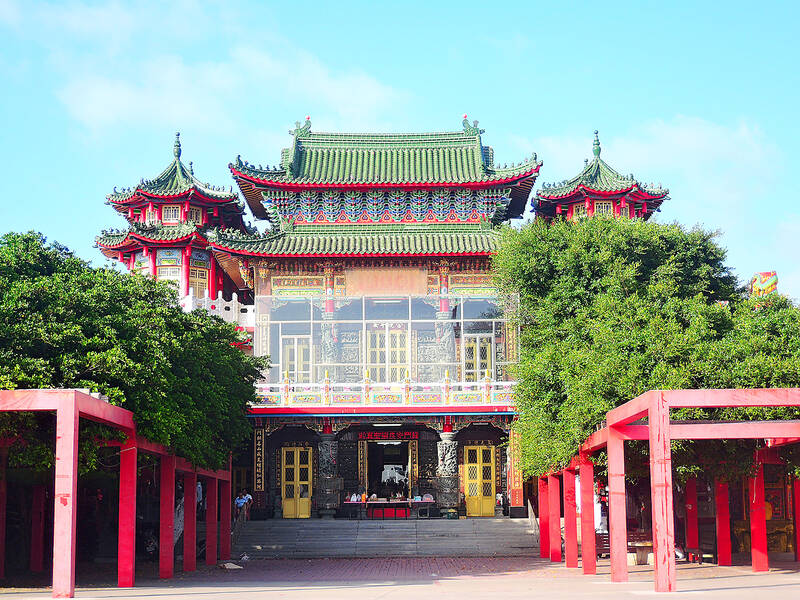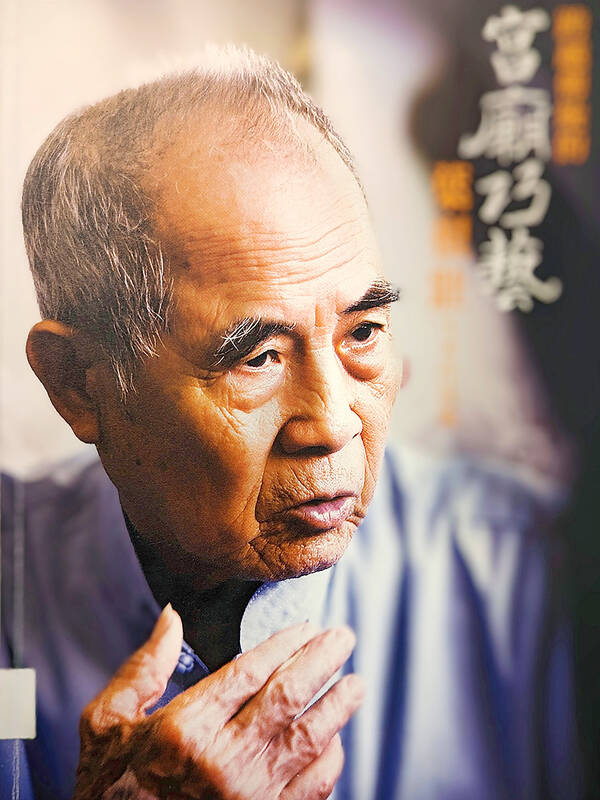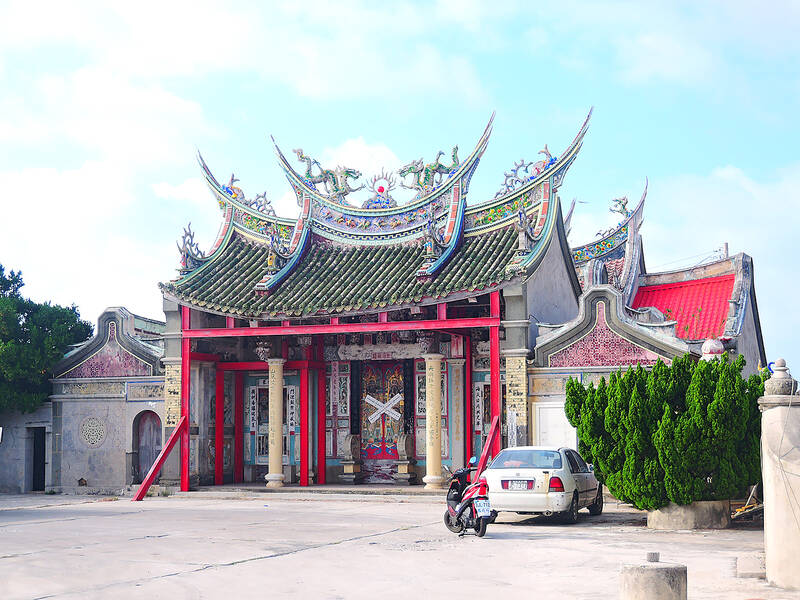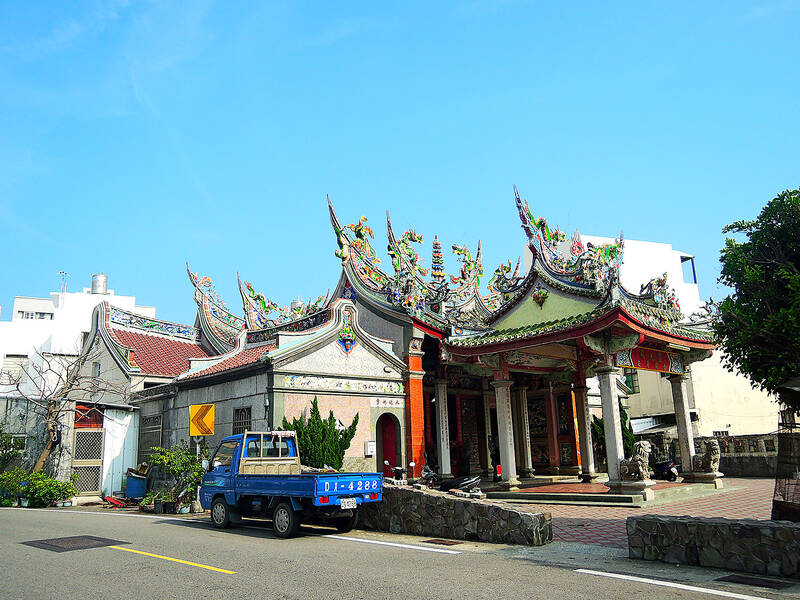July 17 to July 23
When Yeh Ken-chuang (葉根壯) came of age, the traditional skills of architecture and carpentry that had been in his family for four generations were disappearing. After helping his uncle Yeh Teh-ling (葉得令) construct ships, residences and temples for more than a decade, Yeh struck out on his own at the age of 28 in 1960 as a damusi (大木司, chief carpenter), earning his lifelong title “Chief Chuang” (壯司).
Around this time, builders in his homeland of Penghu were increasingly using reinforced concrete instead of wood, due to the humid climate. The period also saw a frenzy in temple construction as the economy improved, meaning there was plenty of work for Yeh.

Photo courtesy of Wikimedia Commons
Adept in non-structural techniques such as doors, windows and furniture, as well as the intricate carvings and detailed decorations that adorned the structures, Yeh was able to adapt his skills, leading the reconstruction of the historic Hsiliao Daitian Temple (西寮代天宮) on Penghu’s main island in 1963.
According to the book Crossing Traditions in Yeh Ken-chuang’s Large-scale Carpentry Skills (宮廟巧藝 :跨越傳統的葉根壯大木作技術), it was Penghu’s first temple that used a purely reinforced concrete structure.
Before his life was cut short, Yeh created more than 70 temples and related structures across the various islands of Penghu and left behind more than 230 building plans.

Photo courtesy of National Central Library
Although Yeh could have built temples and other structures on Taiwan proper, he only worked on a handful of projects outside of Penghu because he wanted to be close to his family.
CLAN OF CARPENTERS
The Yeh family’s woodworking tradition began with Yeh Ma-li (葉媽利), who learned the architecture and carpentry trade from an unknown master on Kinmen. The Yehs trace their roots to Kinmen, although this branch had been living in Penghu since the early 1600s.

Photo courtesy of Wikimedia Commons
Yeh Ma-li was Penghu’s chief temple builder between 1860 and 1890. His daughter-in-law once said that at the height of his prolific career, only three temples on Penghu were not constructed by him. Besides his sons, Yeh Ma-li also took in a young neighbor Hsieh Chiang (謝江), whose later work includes the Guanyin Temple (觀音亭) and City God Temple (城隍廟) in Penghu’s largest town of Magong (馬公). Hsieh’s descendants also became prominent temple builders.
Yeh Ma-li’s grandson Yeh Te-ling became Hsieh’s apprentice since his father died when he was young. Yeh Te-ling was also versed in both large-scale and small-scale carpentry, but unfortunately few temples he built remain.
Yeh Ken-chuang was born in 1932 to Yeh Te-ling’s older brother Yeh Tung (葉東), who was also a carpenter. Yeh Tung, who focused mostly on residences, probably learned from his father Yeh Yuan (葉元), who died before his sons finished their apprenticeships. Only Yeh Te-ling received a complete training under Hsieh.

Photo courtesy of Wikimedia Commons
Yeh Ken-chuang’s formal education was cut short by World War II, so he began working at his brother-in-law’s grocery store at the age of 13. The store’s landlord taught him math and weighing skills as well as how to calculate the amount of materials needed for a job, greatly helping him in his career as a builder.
The brother-in-law died when Yeh Ken-chuang was 17 years old, so the teenager asked Yeh Te-ling if he could help him build Wufu Temple (吳府宮) on Wangan Island (望安). Yeh Ken-chuang would become one of his uncle’s five official disciples, training with him for 11 years and carrying on the family name.
ADAPTING TO THE NEW

Photo courtesy of Wikimedia Commons
During the first years under his uncle, most of their projects were residences and ships. Only later was there a need for temple work suddenly surge. Yeh’s uncle was often gone for weeks overseeing construction across the archipelago, and Yeh was often thrust into the spotlight on projects closer to home. The first temple he completed on his own was the Hsu Village Gangyuan Temple (許家村港元寺), which has been since demolished and rebuilt.
Wood structures in Penghu were susceptible to decay, especially as the strong monsoon winds contained sea salt. Once reinforced concrete became readily available, building methods began shifting immediately.
Yeh employed the new reinforced concrete building methods, and in just his third year in business, he built the Hsiliao Daitian Temple. It was a daring attempt for him, replacing the major supports with concrete and simplifying the complicated wood layering techniques. Yeh still maintained his passion for wood structures, building in that same year the Lungmen Guanyin Temple (龍門觀音寺). He mostly used a combination of timber and reinforced concrete until the mid-1970s, after which he completely switched to reinforced concrete.

Photo courtesy of Wikimedia Commons
Despite the shift, Yeh was able to maintain the proportions, designs and other essential elements of a traditional temple, and use modern materials to create decorations that resembled the old. At the same time, he continued to refine and evolve his knowledge of reinforced concrete construction.
He was enthusiastic about preservation and passing on this traditional knowledge. In 2008, he became an instructor with a Penghu traditional architecture program and was also involved in other ventures.
In 2010, Yeh was nominated by the government as a preserver of large-scale carpentry skills, with the description reading: “He’s adept in adapting his traditional skills to any size, style and construction method. Despite being impacted by the shift in building material, he still adheres to the traditional system required in large-scale carpentry.”
The final evaluation was set for July 29, 2014, and if he passed Yeh would have officially become a “national living treasure” (人間國寶). However, just six days before that day, TransAsia Airways Flight 222 from Kaohsiung crashed near Magong Airport’s runway, killing 47 people. Yeh and his wife were among the victims. He was 82 years old.
Taiwan in Time, a column about Taiwan’s history that is published every Sunday, spotlights important or interesting events around the nation that either have anniversaries this week or are tied to current events.

Exceptions to the rule are sometimes revealing. For a brief few years, there was an emerging ideological split between the Democratic Progressive Party (DPP) and Chinese Nationalist Party (KMT) that appeared to be pushing the DPP in a direction that would be considered more liberal, and the KMT more conservative. In the previous column, “The KMT-DPP’s bureaucrat-led developmental state” (Dec. 11, page 12), we examined how Taiwan’s democratic system developed, and how both the two main parties largely accepted a similar consensus on how Taiwan should be run domestically and did not split along the left-right lines more familiar in

As I finally slid into the warm embrace of the hot, clifftop pool, it was a serene moment of reflection. The sound of the river reflected off the cave walls, the white of our camping lights reflected off the dark, shimmering surface of the water, and I reflected on how fortunate I was to be here. After all, the beautiful walk through narrow canyons that had brought us here had been inaccessible for five years — and will be again soon. The day had started at the Huisun Forest Area (惠蓀林場), at the end of Nantou County Route 80, north and east

Specialty sandwiches loaded with the contents of an entire charcuterie board, overflowing with sauces, creams and all manner of creative add-ons, is perhaps one of the biggest global food trends of this year. From London to New York, lines form down the block for mortadella, burrata, pistachio and more stuffed between slices of fresh sourdough, rye or focaccia. To try the trend in Taipei, Munchies Mafia is for sure the spot — could this be the best sandwich in town? Carlos from Spain and Sergio from Mexico opened this spot just seven months ago. The two met working in the

This month the government ordered a one-year block of Xiaohongshu (小紅書) or Rednote, a Chinese social media platform with more than 3 million users in Taiwan. The government pointed to widespread fraud activity on the platform, along with cybersecurity failures. Officials said that they had reached out to the company and asked it to change. However, they received no response. The pro-China parties, the Chinese Nationalist Party (KMT) and Taiwan People’s Party (TPP), immediately swung into action, denouncing the ban as an attack on free speech. This “free speech” claim was then echoed by the People’s Republic of China (PRC),